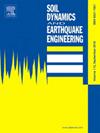Development of seismic resilience index and assessing framework of underground frame structures based on economic loss
IF 4.2
2区 工程技术
Q1 ENGINEERING, GEOLOGICAL
引用次数: 0
Abstract
The seismic resilience of underground structures is one of the critical issues for the development of resilient cities. However, existing assessing methods for assessing the seismic resilience of underground structures do not comprehensively address their seismic capacity and post-earthquake recoverability. This paper developed a seismic resilience index and framework for assessing the seismic resilience of underground frame structures by considering both the damage and functionality of underground structures caused by earthquakes, as well as the processes involved in repairs. The seismic resilience index was developed by quantifying the resist resilience and recovery resilience, which can be used to describe the robustness, redundancy, and resourcefulness of the seismic resilience. Then the assessing procedure for this method is presented step by step. Additionally, a case study was conducted to assess the seismic resilience of a frame subway station, focusing on the economic losses associated with earthquakes. The study also discusses the improvements in seismic resilience achieved through the use of reinforced concrete truncated (RCT) columns. Results indicate that RCT columns can significantly enhance the seismic resilience of underground structures. The reasonability and quantifiability of the developed method were compared with existing methods, demonstrating its effectiveness. Furthermore, the developed assessing method can be extended to assess the seismic resilience of underground structures after quantifying their operational functionality.
基于经济损失的地下框架结构抗震恢复指标制定及框架评估
地下结构的抗震能力是建设弹性城市的关键问题之一。然而,现有的地下结构抗震能力评估方法并没有全面考虑地下结构的抗震能力和灾后恢复能力。本文综合考虑地震对地下框架结构的破坏和功能,以及修复过程,建立了地下框架结构的抗震弹性评价指标和框架。通过对抗御弹性和恢复弹性进行量化,建立了地震弹性指标,用以描述地震弹性的鲁棒性、冗余性和智能性。然后逐步介绍了该方法的评价步骤。此外,本文还对框架地铁车站的抗震能力进行了评估,重点研究了与地震相关的经济损失。该研究还讨论了通过使用钢筋混凝土截短(RCT)柱来提高抗震能力。结果表明,RCT柱能显著提高地下结构的抗震能力。将所建立方法的合理性和可量化性与现有方法进行了比较,证明了该方法的有效性。此外,所建立的评估方法可以推广到对地下结构的运行功能进行量化后的抗震弹性评估。
本文章由计算机程序翻译,如有差异,请以英文原文为准。
求助全文
约1分钟内获得全文
求助全文
来源期刊

Soil Dynamics and Earthquake Engineering
工程技术-地球科学综合
CiteScore
7.50
自引率
15.00%
发文量
446
审稿时长
8 months
期刊介绍:
The journal aims to encourage and enhance the role of mechanics and other disciplines as they relate to earthquake engineering by providing opportunities for the publication of the work of applied mathematicians, engineers and other applied scientists involved in solving problems closely related to the field of earthquake engineering and geotechnical earthquake engineering.
Emphasis is placed on new concepts and techniques, but case histories will also be published if they enhance the presentation and understanding of new technical concepts.
 求助内容:
求助内容: 应助结果提醒方式:
应助结果提醒方式:


